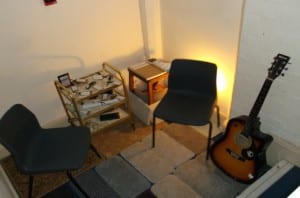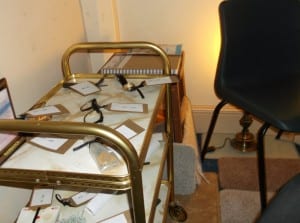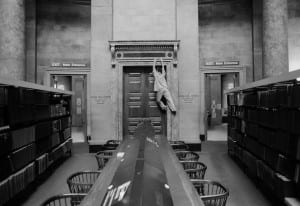Framing Statement
Recollection was a set of one-to-one performances that took place within, what we’ve taken to calling the ‘cupboard’ room, at the Drill Hall in Lincoln. These one-to-ones took place on the 4th May 2016, starting from 12 until 3 and lasting roughly 15 minutes per show. Recollection was developed by three young men whose initial idea for the piece adapted considerably over the process of development however with that came a new understanding of what site specific is and how it is performed, along with why it is used. Because of the performance being one-to-one and there being three performers, one was an audience guide, one was the main performer and another was inactive. We swapped jobs between each performance so that we each had an equal amount of time to do each role fairly.
Recollection, taking influences from many one-to-one practitioners such as Michael Pinchbeck, Jess Dobkin and Eirini Kartsaki, was intended as an intimate, inspirational and educational experience. The performance was set up much like a museum that intended to bring some of Drill Hall’s history to the public through particular objects/artefacts that we collected which we thought we could attach more personal stories and memories to, in order to immerse the audience more to ensure that they gain something from the experience. The audience were asked to wait in the café at their allotted time and would then be greeted by a performer who would guide them to an elevator that takes them up to the ‘cupboard room’ where the museum was set up. Along the way the audience member was offered a toffee and then told a brief story of a soldier who trained at the Drill Hall during World War 1, who used to chew toffee before going into battle in order to calm his nerves.
The audience were then passed along to the main performer who would then lead them through a series of personal memories told through a collection of objects connected to the Drill Hall. We set the objects up in full view for the audience to choose from with chairs set up opposite each other allowing for that intimate conversation.

We wanted our audience members to consist of mainly members of the public and random people who may not know much about the Drill Hall itself and its history because our aim was that the audience leave feeling like they’ve not only just learned something historical but they’ve also gained a personal connection to that history. “What I find most exciting about one to one performance is the opportunity it affords the spectator to immerse themselves in the performance framework set out by the practitioner. This can be a seductive / scary / liberating / boring / intimate prospect and an even more intensive experience” (Zerihan, 2009, 4). We thought that when going to a museum, your experience takes place throughout a number of rooms, all different in size. So we decided to experiment with what might happen if we flip that experience on its head and bring all these objects/artefacts directly to the audience and place them in a more intimate room with no one else around, in order to aid them in gaining the most memorable experience possible.
Process
Upon one of the first visits to the Drill Hall, we were tasked in taking part in a free walking exercise that encouraged us to walk without meaning or thought. This helped us in exploring the aesthetics of the area, the architecture of the building and finding anything that stands out as intriguing that you may not have noticed beforehand in your day to day routines. At first we found a location within the Drill Hall resembling that of a storage cupboard that, once we’d cleared out, found it had some interesting features. The room was quite confined and dark, it was separated by a wooden banister and dipped down; which we though could generate an intense and immersive atmosphere. We also came to notice two plaques on the floor in the outside seating area dedicated to Cpl. James Upton (1915) and L.Cpl. Leonard Keyworth (1915).

This then lead to the development of our original idea entitled Heroism. “The real power of site-specific work is that it somehow activates, or engages with, the narratives of the site in some kind of way. That might be with its formal architecture, or it might be with the character of the building. It might be to do with the history of that building” (Pearson, 2010, 35). We were inspired by the design and layout of the room, combined with the strong historical connection of the Drill Hall to the First World War, that at first we wanted to make an instillation piece set up in a museum kind of way; displaying a life- size recreation of these two soldiers whilst receiving an audio info tour of their lives through headphones. However we realised that the design and style of the room had an immersive and intense feel, to which we thought we could physically capture these soldier’s lives and their experiences.
We then tried to recreate an experience in the trenches that the audience could be emotionally stimulated by. With the absence of natural light, the confined atmosphere and the lowered floor towards the back of the room, we realised that, if we could dressed it up a little, it provided us with an elegant location to frame our idea.
Mock trail of trench recreation:

After building on our idea we visited the Lincolnshire archives to gather more information on the history of these soldiers and on the Drill Hall itself. It was a useful experience, giving us access to decades of info on what the Drill Hall was before what we know it to be as now. We learned that the soldiers trained at the Drill Hall during the war and that Upton and Keyworth both won the Victoria Cross for acts of bravery, which we then developed our piece in the trench on. The archive trip also taught us that not only was it an army training base as well as a theatre, but it was also venue to major musical talents such as The Rolling Stones, The Attractions, Judas Priest and Iron Maiden. It was also a saw mill in the 1800’s as well as playing host to a formal gentlemen’s club, a polling station and even an unfortunate death involving a school girl during gym class. The visit to the archive was very beneficial to us because all this information aided our final piece.
After performing our piece to others several times and receiving feedback, two things became apparent to us. We may be trying to take on too much with too little of a budget and also that it was becoming slightly too theatrical. We were found we were slipping too much into the characters of the soldiers and creating a piece that revolves too much around spectacle. By putting people into the lives of the soldiers and into the trenches we were drawing their attention away from the site of the Drill Hall itself. “My work has always been about a desire to converse and connect intimately with an audience. Part of what initially drew me to performance was the immediacy of the form and the possibilities for interaction” (Dobkin, 2009, 23). We wanted to keep the intimate atmosphere and the stories of the soldiers but keep the attention and focus on the Drill Hall. We thought that we could, instead of re-creating these stories in a theatrical way; we could simply guide them through the stories and set up a comfortable, calm yet intense environment. The aim to just converse with the audience, so they have the ability to ingest the information they’ve been given and we can take time to draw their attention qualities of the space around them. Therefore after considering this we researched into how one-to-one performances can aid us in interacting with the audience.
“The Long and Winding Road, is a journey that perhaps in one way or another we have all taken or seen a close friend take. It is about the experience of loss, memory, mourning and recovery” (BBC online, 2009, 62). This was a site-specific performance devised by Michael Pinchbeck in 2004 which helped inspire the design of Recollection. Pinchbeck’s performance involved a number of personal and private objects, belonging to a lost family member; each holding their own specific memory. We liked the idea of each object having its own personal story as we believed it helped build a connection between the performer, the audience member and the site itself. At some point throughout the process I was advised by Michael to draw map of the Drill hall and label my emotions and experiences I had for each room. We believed that if we somehow involved stories from across the Drill hall instead of just the soldiers, then we could almost draw an imaginary map for the audience of the Drill Halls experiences.
At this point we agreed that the performance would take place almost like a museum exhibit, involving certain objects that have been given personalized memories relating to the Drill Halls past. Using the information we gathered from the archives, along with information gathered by other groups, we were able to collate an archive of our own on the Drill Hall. After finding carpet samples left in our performance space one day, we used this to our advantage and set the room up to feel almost like a living room setting in order to make the area seem more inviting. We made a mission for each of us to collect enough mementos that we thought could relate to the facts we found about our site. After this we were left with adding small details in order to make the performance that little bit more professional. For example creating a catalogue book for the item information to be recorded in and taking care of the objects we have, in order to give the impression that these artefacts preserved, as if they were in a real museum.
Evaluation of performance

“[…] Artists predominantly respond to a place from the perspective of an outsider and considers the problems and possibilities that this affords to the creative encounter” (Govan, 2007, 120). Throughout the process and on the day of performance we faced many problems, but also encountered an equal amount of possibilities. We realised that through the problem we had of it being too theatrical, gave birth to the use of personal objects which gave us the possibility of using these objects to point out characteristics of the site.
The intro and exit from the performance I believe gave us a great opportunity to give the audience member some time to explore the features of the Drill Hall and gain a comfort of their surroundings before entering the space. It helped us to give the audience member a brief understanding in to what they were about to experience and also gives them a sense of being guided, like they were safe and being taken care of. The intro also enabled us to add a nice piece of relevant information we collected regarding Cpl. Upton. “I offered audience members a travel sweet when they arrived, an invitation to relax, to feel like they were going on a journey” (Pinchbeck, 2009, 63). Upton was sent toffee by his sister that he would chew to calm his nerves before going into battle. Taking inspiration from Pinchbeck’s The Long and winding road and from Upton’s story of toffee, we offered some to the audience and told his story as conversation starter which linked nicely to the performance itself.

However we did face a problem regarding the intro and exit half way through the day. We realised that the time we’d given to perform didn’t include the time it took to walk the distance from the performance area to the waiting area and how long the lift might take; therefore sometimes we weren’t left with enough time to converse as intimately as we’d hoped with the audience on the guide. If we were to do this again I would definitely reconsider how the audience were guided in and out in order to make it smoother.
A concern that we had about the main performance was how it was to be presented. Something we all struggled with at some point was in what manner to deliver these stories and just how to guide the audience through them as comfortable as possible. After more and more rehearsals and by familiarising ourselves with the items we had, combined with the facts we knew; we eventually gained the confidence to be able to commit to the stories we were telling. Once we’d made ourselves comfortable with what we were doing and saying it then became easier for the audience to find comfort. In turn this then led to them engaging more with the stories being told. I believe that we did well in giving the audience an educational and emotional experience and I firmly believe that a lot of audience members left having learned something. I think we exceeded in making them feel greeted and comfortable when in the space and I think that the objects we collected worked well with the stories we linked to them. The timing could have been improved by allowing extra time for the journey and in case the lift was being temperamental. It might have seemed more inviting also if we had the time and budget to decorate the room a little more to add to the living room effect.
If I were to do this again I might scatter the objects throughout the Drill Hall and organise a treasure hunt kind of tour that spreads the objects throughout the site for the audience to find using the information as clues to their location. This would get them moving around the site more taking in the spaces and architectural qualities around them as they explore; so they can almost see the history for their own eyes.
Word count: 2357
Works cited
Zerihan, R (2009) Study room guide: One to one performance. [Online] Available from http://www.thisisliveart.co.uk/resources/catalogue/rachel-zerihans-study-room-guide
[Accessed 9th May, 2016]
Dobkin, J (2009) Study room guide: One to one performance. [Online] Available from http://www.thisisliveart.co.uk/resources/catalogue/rachel-zerihans-study-room-guide
[Accessed 9th May, 2016]
BBC Online (2009) Study room guide: One to one performance. [Online] Available from http://www.thisisliveart.co.uk/resources/catalogue/rachel-zerihans-study-room-guide
[Accessed 9th May, 2016]
Pinchbeck, M (2009) Study room guide: One to one performance. [Online] Available from http://www.thisisliveart.co.uk/resources/catalogue/rachel-zerihans-study-room-guide
[Accessed 9th May, 2016]
Pearson, M (2010) Site-specific performance, London: Palgrave Macmillan.
Govan, E (2007) Making a Performance: devising histories and contemporary practice, New York: Routledge.
